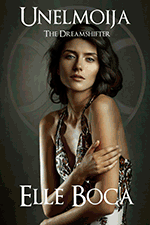Luxury Travel Review

What we liked about Naples, Italy
By Elena del Valle, photos by Gary Cox
Naples was one of the stops in a spring multi-city trip we made to Italy earlier this year. Although in past years my travel partner and I had visited the region more than once, it was the first time we stayed in the coastal city. We arrived by train from Rome on a bright and sunny Tuesday at lunchtime to discover a lively and colorful city.
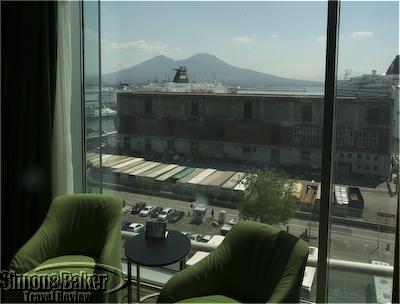
On a clear day we could see Mount Vesuvius from our hotel
Within minutes we had maneuvered through the heavily trafficked central area to the quieter port district where our modern 10-story glass fronted hotel stood. The interior was art filled and cool. We relied on Only in Naples, a 107-page book of favorite places at our hotel, and staff recommendations to plan our discovery of the city. An hour after we stepped off the train we had settled comfortably in our hotel suite and gone for a two-hour walk near the hotel and on Via Francesco Caracciolo, a busy water hugging road where many of the tourist hotels were located. The sky was a perfect Mediterranean blue although outdoors and by the sea it was chilly and breezy. On our way back we stopped at the Gran Caffe Gambrinus in the San Giuseppe area of the city center where we had Neapolitan snacks and espresso.
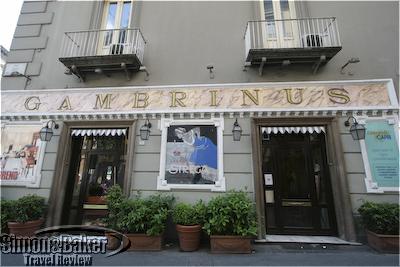
Cafe Gambrinus in Naples
That night we went to Pizzeria Sorbillo (Via dei Tribunali, 32, 80138 Naples, Italy, telephone +39 081 446643, in Italian www.accademiadellapizza.it/), where we had the most delicious pizza we have ever tasted in a two-story pizza shop in the old town. We arrived at the third generation restaurant founded by Gino Sorbillo in 1935 in the early evening to find it was half full. We sampled three pizzas which we washed down with beer. By the time we finished dinner the restaurant was full and there was a line of people on the street in front of the entrance waiting to be seated. Our host, who lives in Naples, explained it was like that every day. With our bellies full and a smile on our faces we walked in his amiable company back to our port fronting accommodations.
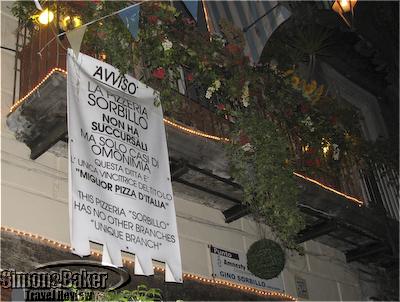
Pizzeria Sorbillo
The following afternoon we went walking again. This time we found Gay-Odin Fabrica di Cioccolato (Via Toledo 427, Naples, Italy, telephone +39 081 551 3491, in Italian www.gay-odin.it) described in our book as the city’s premier chocolate makers. We stopped at a shop near the big shopping center, one of nine Gay-Odin stores in Naples and one each in Rome and Milan. The artisan chocolate makers sold a variety of the hand made chocolates in individual pieces and varying package sizes. Although the bite size morsels drew my eye it was rather hot that afternoon and we were concerned the chocolate would not hold out very long. We purchased a small Foresta made with milk chocolate with the intention of returning to buy more if we liked them. As it turns out we did like it and it quickly disappeared. Unfortunately, we never had a chance to return. Next time…

The streets of Naples were vibrant with shoppers and street vendors
The following afternoon, Gaia Montuoro, public relations and events manager at our hotel, invited us to see her hometown. In her company we visited more of the old town. We descended below ground level to see ancient ruins dating to Roman and Greek times at the Complesso San Lorenzo Maggiore. The archeological site that was discovered beneath the church, convent and cloister by the same name is a street three meters wide by 60 meters long surrounded by an ancient Roman market. Under the Roman ruins history lovers discovered older Greek remains. In places we could see the colored tiny tiles which, Gaia explained, likely represented wealthy residences. It was one of our favorite stops. More information, in Italian, at www.sanlorenzomaggiorenapoli.it/
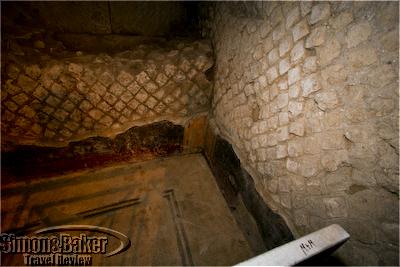
Ancient ruins underground in Naples
On our way to the Greco-Roman ruins we stopped in Ferrigno (Via San Gregorio Armeno 55, www.arteferrigno), the shop of an artisan nativity figurine maker before we were caught in an afternoon shower that sent us running in search of an umbrella and shelter. Giuseppe and Marco Ferrigno carry on a tradition that has been going on for nearly 200 years. They and their employees make some 500 rather elaborate terracotta, wood and silk nativity scene figurines. With the owner’s permission (spring is not a popular time for nativity figure purchases so the interior was dark) we visited the two-story shop where hundreds of figurines up to 40 centimeters tall were on display.
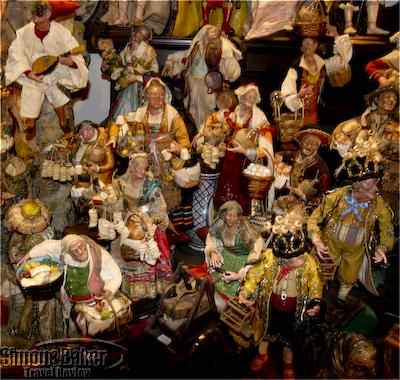
Lifelike Nativity figurines
After we exited the San Lorenzo Maggiore ruins we stopped at the alchemist chapel or Cappella Sansevero (Via Francesco De Sanctis 19/21, 80134, Naples, Italy, telephone +39 081 5518470, info@museosansevero.it). The small space was crowded, perhaps especially so because of the rain outdoors. It housed religious art including two sculptures that stood out, The Veiled Christ by Giuseppe Sanmartino and The Veiled Truth. It was the basement that had drawn a crowd requiring us to wait for them to conclude their visit. They were observing the two anatomical exhibits of the skeletons and circulatory system of a man and a pregnant woman, Anatomical Machines, thought to have been the result of treatments on live humans; it appears scientific analysis indicates the specimens were made with iron wire, silk and wax. More information, in English, at www.museosansevero.it/index_ing.html
We then stopped at the working study and art gallery of one of Naples’ sons, Lello Esposito, a friendly artist known for his distinctive Neapolitan themed work. We were invited in to browse. As we walked through his art gallery (Palazzo Sansevero Piazza San Domenico Maggiore, 80134, Naples, Italy, lelloesposito.com, info@lelloesposito.com) we saw large distinctive and bold sculptures. Esposito, who had exhibited his art internationally and lived in New York for several months, welcomed us in Italian and shared his hope to one day prepare a United States themed exhibit.
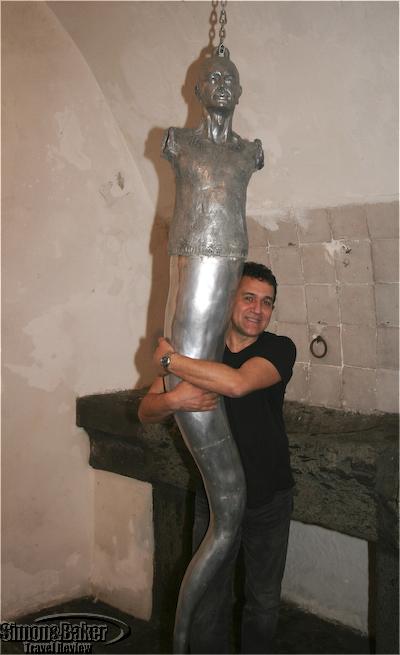
Lello Esposito with one of his artistic creations
That evening after we recovered from our extended walks we stopped at Zero Sushi Bar, a sushi bar with a Japanese chef, on the ground floor of our hotel. The few bites we had were yummy and left me craving more sushi until a few minutes later we made our way to Il Comandante for a surprisingly delicious tasting menu.
Every outing and every meal we had in Naples was surprisingly satisfying. Starting with our comfort oriented luxury suite with a view at the Romeo Hotel and the staff’s warm welcome and guidance our visit to Naples was a great success. We look forward to a return visit.
A surprisingly delicious dinner at L’Albergo della Regina Isabella in Ischia
By Elena del Valle, photos by Gary Cox
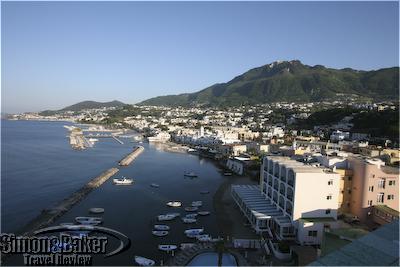
Lacco Ameno in Ischia
This spring while we visited Ischia, an island off the west coast of Italy in the Tyrrhenian Sea we stayed at L’Albergo della Regina Isabella hotel. Our last night on the island we had an unexpected and delicious gourmet dinner at the hotel. Although Ristorante Indaco, the hotel’s gourmet restaurant, was closed for renovations we were able to sample an Indaco Tasting Menu in the hotel’s main restaurant. Chef Pasquale Padamaro, a native of Ischia, and his staff prepared an exceptional meal which we enjoyed along with a splendid night view of the Lacco Ameno town and nearby coast.

Handmade breadsticks and appetizers
To start there was a welcome bite of Piadina con prosciutto crudo San Daniele; also cheese, breadsticks with sesame and bread, Ricotta di bufala e acciughe di cetara, Grissini al sesamo, and Streghe. Octopus and fish tartar: Polpo alla piastra e fagioli; Antipasto tartar di palamito al basilico e cipollina le uova e il fegato alla genovese, colatura di insalata di pomodori piccatilli were next. For first courses we had: pasta with shrimp and basil sauce (a favorite), Linguine di giacomo santoleri al farro e orzo con pesto di basilico e scampi; and tiny raviolis, Cappeletti di mantecato di pezzogna con patate e provola.
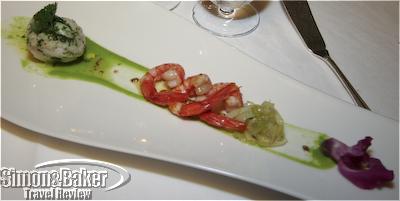
Monkfish with shrimp
The second course was a monkfish with perfectly cooked shrimp, Medaglione di pescatrice agli aromi e lardo di colonnata con passata di rucola e senape e gamberoni appena scottati. Pre-dessert was Centrifugato di avvogato e jogurt magro with chocolate followed by a strawberry medley dessert of strawberry cone, strawberry ice cream, and baignet of wild strawberries, Il Viaggio del pasticcere. A tray of bite sized baked sweets accompanied our hot beverages at the end of the meal.
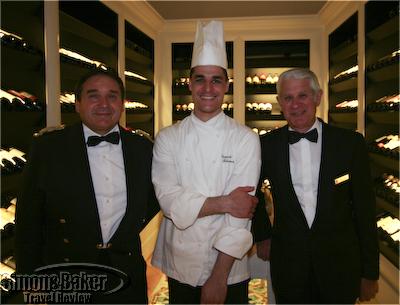
Our server, the chef and the maître d’hôtel
Carmine, our server, spoke English and translated the menu each time a course arrived. The pretty dinnerware that varied with each course, artistic presentation of the food including tiny flowers on the plates and an island wine to match the meal, Pigna Nera Tommasone 2006 (although it was too stout for the delicate flavors of our dinner it would have been a worthy accompaniment to a bold winter menu) rounded out the experience. The next time we visit Ischia we look forward to another dinner at the newly renovated Indaco restaurant. Click here to read about our stay at L’Albergo della Regina Isabella.
TIES seeks to recognize best practices of sustainable tourism
The International Ecotourism Society (TIES) launched the annual Innovation Leadership in Sustainable Tourism Awards to recognize individuals and organizations who demonstrate leadership in innovative actions that promote sustainable tourism and bring tangible benefits to communities and conservation. The Award winners, one individual and one organization, will be honored for their best practices and innovative actions, based on one example of an innovative project, product, or program developed in the previous year that supports the goal of uniting communities, conservation, and sustainable travel.
Award applicants need not be members of TIES. Submissions will be judged by the organization’s Advisory Board based on one example of an innovative project, product, or program developed in the previous year that advocates for uniting communities, conservation, and sustainable travel.
Applications must be submitted online by August 2, 2010. Finalists will be announced by August 6, 2010. The top ten finalists’ submissions (five individuals and five organizations) will be posted on Your Travel Choice Blog from August 6, 2010 to August 20, 2010. Project stakeholders, supporters and TIES members will be encouraged to comment on finalist submissions. The advisory board will take testimonial comments in making the final selections August 25th, 2010.
The winning two finalists will be honored at the Ecotourism and Sustainable Tourism Conference 2010 (ESTC 2010), receive one free registration to ESTC 2011 and be recognized through TIES website, ESTC website and e-newsletters. More information on TIES Innovation Awards and nomination instructions are available at: www.ecotourism.org/innovation-awards.
Intimate luxury hotel redefined medieval romance of Bruges for me
Article and photos by Josette King
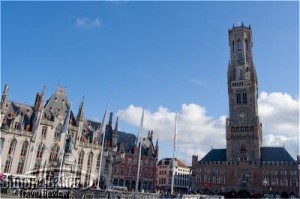
The Grote Markt is a favorite gathering spot with tourists
Bruges is unique; a city where time stood still at the height of its grandeur, half a millennium ago. Today, with most of its medieval architecture intact and its 430 hectare (1.6 square mile) historic center, it is one of Europe’s most picturesque cities; one that draws an estimated two million visitors a year, many of whom come for the day. European high-speed trains have put Bruges within an easy three-hours’ reach of Paris, Amsterdam, London, and the western part of Germany, allowing sightseers a quick look on their way from one capital city to the next.
These daytime tourists tend to congregate around the Grote Markt (Market Square), the grandest square and commercial heart of medieval Bruges since the thirteenth century, dominated by its 272 foot (83 meter) belfry, and the Burg (Town Square) that was, and remains, its administrative core. The cobbled streets surrounding the two squares are conveniently lined with shops brimming with the chocolate and lace for which the city is famous, ensuring that visitors do not have to stray far afield to make the most of their excursion.
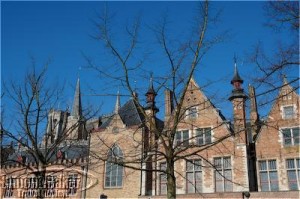
Gothic mansions in the morning sun
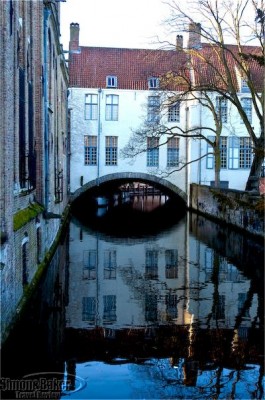
A medieval home mirrored in an ancient canal

The Beguinage is a serene retreat at the edge of the city
But a few minutes’ walk away in any direction, the true romance of Bruges unfolds. It becomes an uncrowded, magical medieval place where time references fade away. That is the Bruges which has drawn me back several times over the decades, to leisurely wander in a world unchanged for centuries. Regal swans glide by canal-side homes and humpbacked stone bridges lead into mazes of narrow streets opening onto squares bordered by stately Gothic mansions, or culs-de-sac surrounded with whitewashed almshouses. There are always surprises, previously overlooked gems to be discovered.
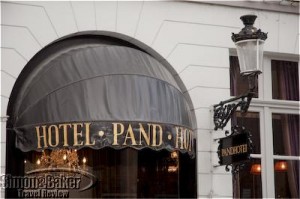
The Romantik Pand Hotel was a welcoming haven of luxury
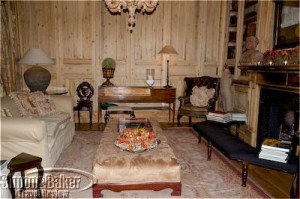
The library at the Romantik Pand Hotel

My suite overlooked the medieval skyline
On my recent visit one such jewel was the Romantik Pand Hotel, an early eighteenth century carriage house on a tiny tree-shaded square in the heart of the historic center. Owned and managed by the Vanhaecke family, the property had been lovingly transformed into a luxury boutique hotel. Personally decorated by Mrs. Chris Vanhaeke, an enthusiastic antiques collector, with superb pieces from her collection, it had the authentic feel of a gracious home from a bygone era (with the welcome addition of a whirlpool bath and WiFi Internet access in my suite).
The pleasure of my visit was further enhanced by the genuinely thoughtful hospitality of the management and staff, and the sense that no detail had been overlooked to ensure that I would feel truly at home during my visit with them. In fact, as I look back on my stay at the Romantik Pand Hotel, I suspect it may have altered the way I will think of future visits to Bruges. From now on, it will probably start with a yearning to return to the Pand, with the added bonus that it sits in the heart of one of the most romantic cities in Europe. Click here to read more about my visit to Bruges and my stay at the Romantik Pand Hotel.
Ecotourism and Sustainable Tourism Conference (ESTC) 2010
Information provided by our Event Partner

Ecotourism and Sustainable Tourism Conference (ESTC) 2010
September 8-10, 2010
Portland, Oregon (USA)
The Ecotourism and Sustainable Tourism Conference (ESTC) 2010 (www.ecotourismconference.org) (September 8-10, 2010) will bring together 500+ business leaders, travel and tourism professionals and community stakeholders from around the world, providing THE meeting place to share the latest trends in sustainable tourism, practical ideas and solutions to the sustainability challenges facing the tourism industry.
Hosted in Portland, Oregon, a leading U.S. city that has been consistently rated “the most sustainable city” in the country, the ESTC 2010 will feature dynamic panel discussions and field sessions, public forums and social functions that offer eye-opening insights into the latest on sustainable business strategies and unparalleled networking and knowledge-sharing experiences. The ESTC is organized by The International Ecotourism Society (TIES), with the support of conference sponsors and partners.
TIES welcomes Simon & Baker Tourism Review as a Media & Communications Partner for the ESTC 2010, and is pleased to extend a special partner discount (10% off regular registration rates) to all SBTR subscribers. To take advantage of this discount, please use this code ESTC10SBTR when registering for the conference (www.ecotourismconference.org/register).
A visit to Saint Lucia
Photos by Gary Cox
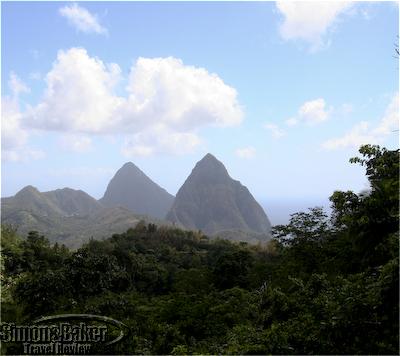
The distinctive Saint Lucia Pitons
Mention of any Caribbean island conjures images of white sand beaches, luxurious hideaways, tropical drinks, and exotic meals. One of the islands many landlubbers dream about is Saint Lucia which one of our teams visited earlier this year on a mission to discover the former British colony’s charms. Located in the eastern Caribbean between Martinique, a French island, and Saint Vincent, part of Saint Vincent and the Grenadines, Saint Lucia is recognized often thanks to two distinctive hills called Pitons. It is also known for its active volcano, lush mountainous landscape and more recently for its vibrant tourism development. Read about their experience in Saint Lucia at The Jalousie Plantation and the Cotton Bay Club, the two hotels they stayed in while on the island.
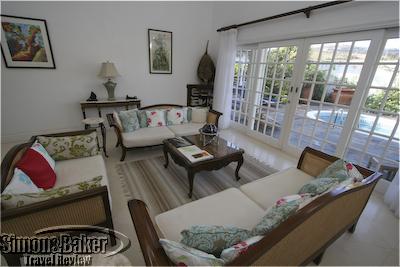
The living room in Villa 45 at Cotton Bay Village

The Jalousie Plantation beach and pool areas

A beautiful hummingbird visiting the flowers in Saint Lucia


